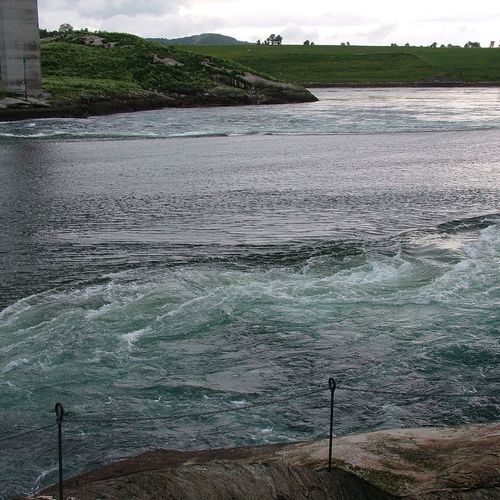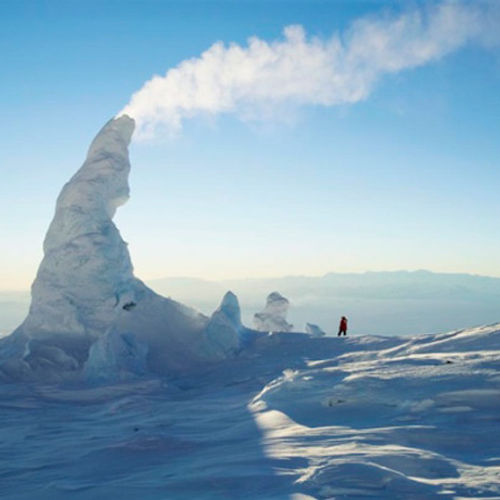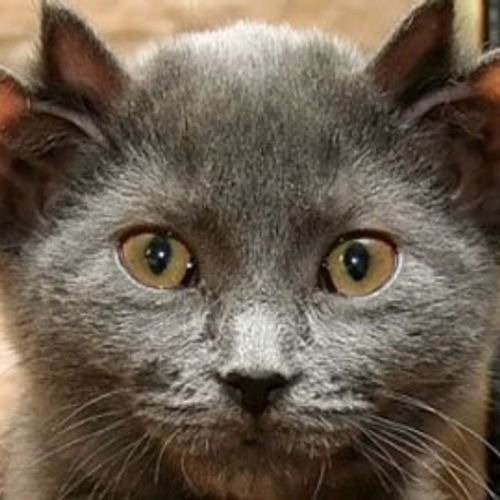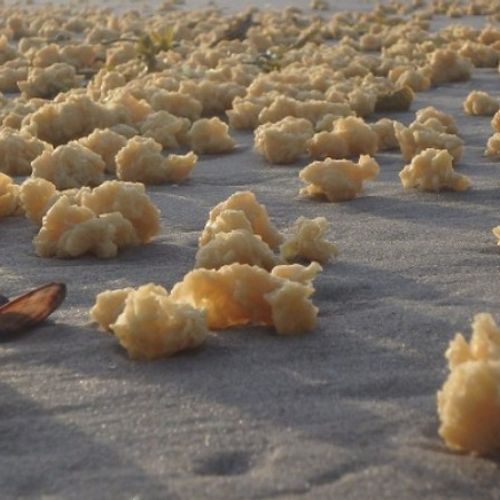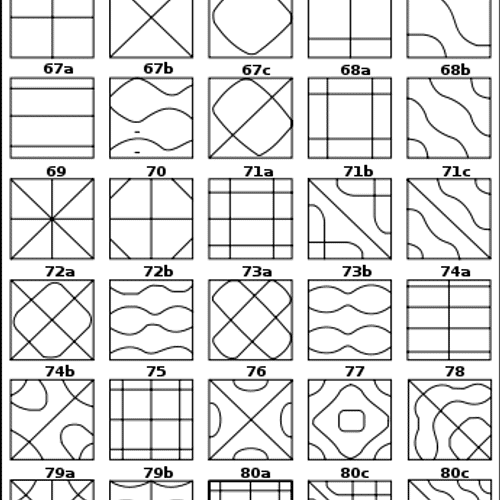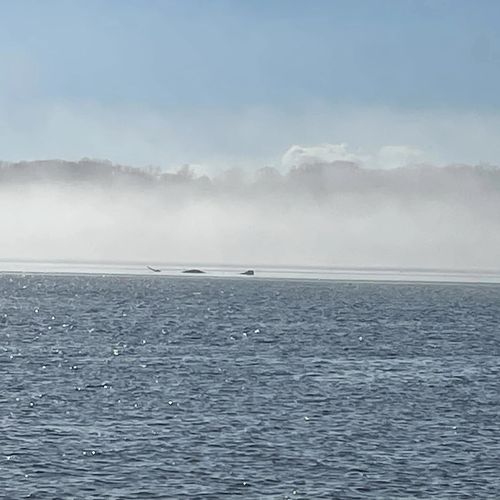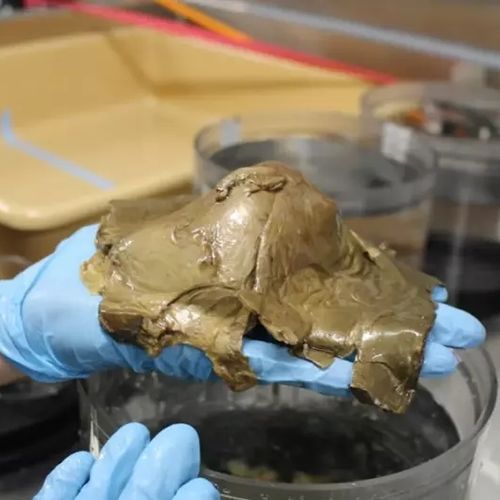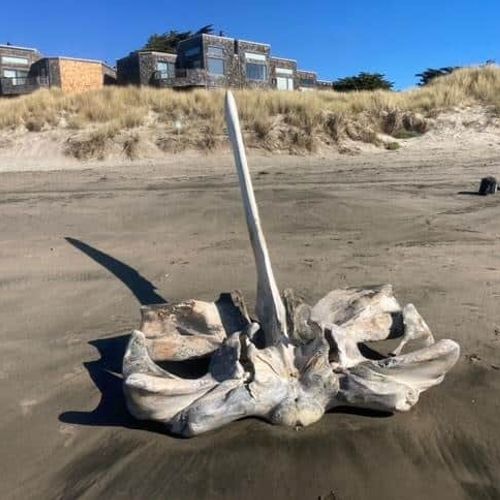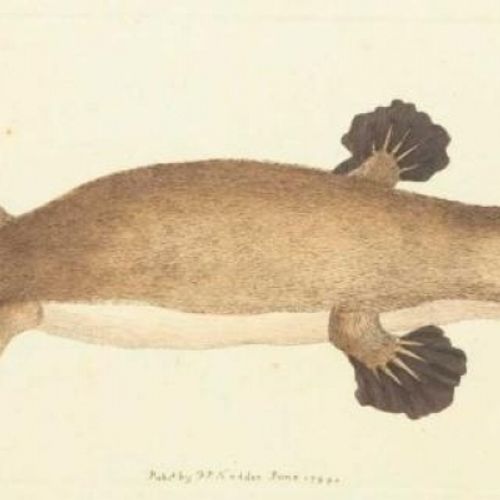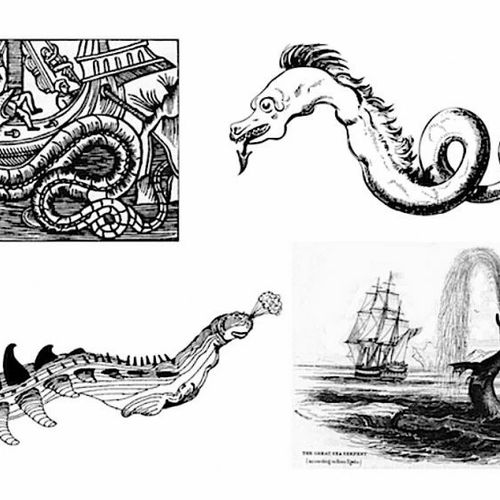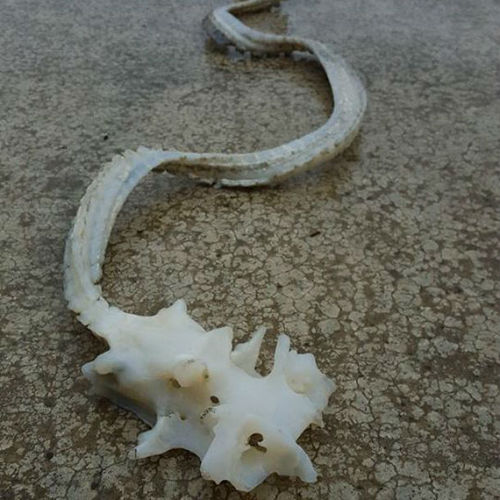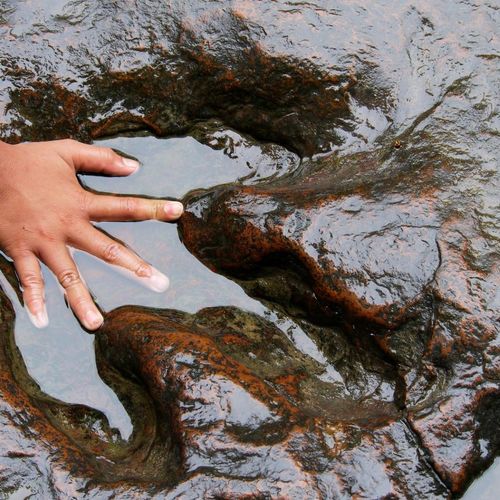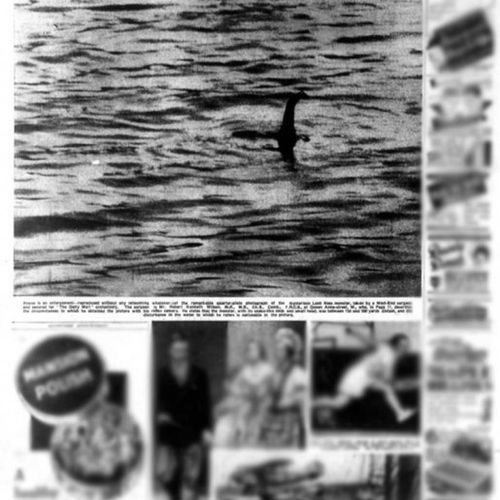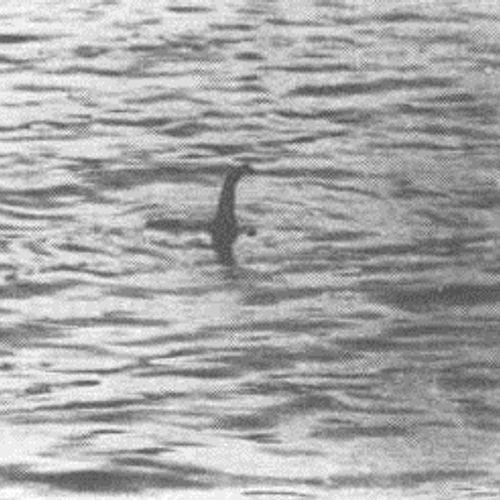
| Added | Fri, 07/04/2017 |
| Hierarchy | |
| Область распространения | All over the world |
| Характерные признаки |
Place →
Place → Reservoir
|
| Sources |
In addition to beings that are considered reasonable (e.g. mermaids), humanity for many centuries, holds legends of water monsters. These terrible monsters inhabit all water bodies, from oceans to small lakes.
These creatures are usually described as giant snakes, lizards and squid.
Lake
The most famous being, perhaps, live in the lake, is Nessie. According to legend, it inhabits the Loch ness in Scotland. The researchers (who are referred to as "cryptozoology") believe that the first of the Loch ness monster is mentioned by Roman legionaries. The legend of the creature (Calpi), living in lakes, is also present in Scottish folklore. However, the worldwide fame it acquired after the publication of the so-called "surgeon's photograph" (Surgeon photo), made by the London physician R. Kenneth Wilson in 1934, which turned out to be a hoax. However, in the Wake of the popularity of the monster was made many other pictures.
The seas and oceans
Monster of the deep sea have long been known to sailors and become part of their legends. Stories about the monsters that inhabited the seas appeared almost before the Maritime and successfully survived until our days.
One of the well-known marine life according to these legends is the Kraken. It's a mythical sea monster looks like a cephalopod mollusc of gigantic proportions. He became known by the descriptions of Icelandic sailors. One of the most famous documented descriptions of this creature was given by captain Robert Jameson and the sailors of his vessel, under oath in court and published in "St. James Chronicle" at the end of the 1770-ies. A description of what they saw in 1774: a huge body of up to 1.5 miles in length and 30 feet in height that it appeared from the water, then sank and finally disappeared "under extraordinary agitation of the waters." After that they found this place so many fish that it filled almost the entire ship.
Second in popularity after the giant squid creatures mentioned in ancient legends, is a giant snake. For Example, Cadborosaurus. This hypothetical marine reptile supposedly lives off the coast of North America. It is very similar to the sea serpent with a long body and a head like a horse.
River
Mythical creatures spotted in the rivers, significantly less than in the oceans, seas and lakes. Famous enough to find their individual name and worldwide fame, not at all. Typically, they are described as giant fish with huge teeth or snakes unnatural sizes.
Version
The basic version, trying to explain the existence of the above beings, the following:
- Relict of the cryptids, as yet unknown to science animals (a huge fish, long-necked seal, giant clam, etc.) that were able to survive to the present day, undetected.
- Known creatures accidentally been taken over by monsters.
- Inanimate objects are taken for monsters: logs, debris, waves, etc.
- A deliberate hoax.
In addition to descriptions of eyewitnesses, photos and video evidence, find the bodies of creatures that fit the description above. This is not surprising because it is rare, but these creatures are real and recognized by official science. For example, a giant squid oceanographers found in 2004.
Translated by «Yandex.Translator»
Phenomena with similar tags
Phenomenon in mass culture
Phenomena
A-Mi-Cook
In Inuit mythology, a sea monster that lives in the waters of the Bering Strait around the city of St. Michael, washing Alaska.
Ä-mi’-kuk is the original spelling of the name.
He attacks kayakers who have sailed far from the shore, and drags them to the bottom with the help of tentacles. It is covered with slime and is able to move easily both under water and ice, and underground (when it breaks through tunnels, lake water goes into the sea, when it returns, the water also returns).
Avank
A creature from Welsh mythology. This aquatic creature, looking like a huge crocodile or beaver, drags under the water. cattle and sometimes even people.
Avanc lives in a pool called Llyn-yr-Avanc (Llyn yr Afanc) on the river Conwy in the North Wales.
Azhdaha
A character of ancient Iranian mythology, an evil demon. In the Tatar language – Azhdaha, in ancient Iranian – Azhi Dahaka, in the "Shahnameh" Firdousi – Zahhak.
The image of Azhdakhi appeared in ancient Turkic mythology in the era of Zoroastrianism (XV–VI centuries BC).
The Ayia Napa Monster
An aquatic creature from the folklore of Cyprus. This is a huge crocodile-like creature. According to the descriptions of eyewitnesses, it looks like something similar to a crocodile or a huge snake. It has a shell, a crest, a mouth full of sharp fangs. He is sometimes called "The Felico Teras" i.e. "friendly monster".
The animal often appears near cities. But the most favorite place of the Cyprus Lochness is Cape Greco, the easternmost point of the island, located a few minutes drive from the city of Ayia Napa and is a habitat for rare plants.
Albasta
A demonic character in the mythology of the Turkic and some neighboring peoples.
Ama-biko
According to Japanese beliefs, a half-man is a half-fish with a bird's beak that appears in the sea and predicts the future. From afar at night it looks like strange lights on the water. It is believed that he looks like a mermaid or a newt with three legs.
Similar or identical to Amabie.
Amabie
In Japanese mythology, a mermaid-like three-legged creature with a beak, combining human and fish features. He has long hair and a scaly body. As well as a beak-shaped mouth and three legs. It glows with a bright light that can be seen from the coast.
Anki-Kiele
The spirit of the sea from Chukchi and Eskimo mythology. It has a huge shaggy head with two eyes and a large toothy mouth.
Anki-Kiele could send a good catch of fish or success in the extraction of other marine life. This could be achieved by sending the shaman's soul to him.
Apotamkin
Apotamkin (Apotamkin (or apotampkin) is a creature from Indian mythology.
This is a giant fanged sea monster that lives in Passamaquoddy Bay and attracts people, especially careless children. He is said to have long red hair, and in some versions it was a human woman before she turned into a snake.
Bagnik
In Belarusian mythology, a swamp spirit inhabiting a bagna (peat bog or bagna). Belief in him is especially widespread in the Vitebsk province. It betrays its presence by bubbles on the surface of swamp slime, unusual sounds and small lights flying over it.
He is described as fat, eyeless, blind, very dirty.
At the habitat of the Bagnik, you can see a black dirty puddle that does not freeze even in severe frost, which is not covered with vegetation, but seems to breathe.
Balamuten
A creature from Belarusian mythology. This is a dangerous water man with a puffy face, goose bumps and a huge belly. He is very loving, for which he kidnaps women: he casts a spell and takes it with him under the water. After playing enough, he returns it back, and the woman acquires the privilege of never drowning.
Balamutnya should be feared in the evening, as he is afraid of the sun.
Balamutnya can be considered a kind of special subspecies of water-incubus.
Bedn-vara
Aquatic creatures from the folklore of the inhabitants of the Isle of Man. She looks like a mermaid. Usually helps people: points to treasures, helps to swim out, warns about storms, etc., but if someone falls in love very much, he can drown them to be together forever.
Byu
In ancient Chinese mythology, a monstrous turtle fish or a one-horned dragon fish with four legs.
According to various descriptions, she has the body of a fish, and the head, arms and legs are human.
This huge (could easily swallow a boat) fish lived in the sea, but could also live on land. The creature's back and belly are covered with sharp spikes. As soon as the fish appeared on the surface of the sea, a fierce wind began to blow and large waves rose.
Billdad
A formidable animal from the folklore of North American lumberjacks.
The Billdad lives only around the Boundary Pond, in northwestern Maine. A fish-eating animal, it hunts, waiting in grassy areas with many insects. When the fish comes to the surface to try to eat the beetle, Billdad jumps over it with amazing speed and hits his tail hard enough to stun the fish, which the creature eats shortly after. The sound is similar to rowing, and canoe is sometimes confused with Billdad, and vice versa.
Bildad
Bildad (Billdad or Saltipiscator falcorostratus — pseudoscientific Latin name of Bildad) is a beaver-sized animal in the folklore of American colonists, with long hind legs like a kangaroo, webbed feet and a heavy beak like a hawk. It lives in water. He jumps high and moves quite fast.
Swamp Monster
A creature from the folklore of the USA. He lives on Honey Island (Honey Island) among the swamps.
The indigenous inhabitants of these places (Indians) call this creature Letiche, and the legends about it are several hundred years old. The word Letiche itself can be roughly translated from the local Indian language as "carnivorous aquatic humanoid". Locals call the monster Tainted Keitre.
Buvaya
In Tagalog folklore (Philippines), a giant crocodile-like demon sleeping at the bottom of the ocean, collecting people's souls in its coffin-shaped shoulder chest. He is the guide of the souls of the dead to another world.
Bukavac
A creature from Serbian mythology in the form of a six-legged monster with deer horns. He lives in large reservoirs (lakes, swamps), and at night, coming out of the water, makes a lot of noise, jumps on people or animals and strangles them.
Bullesbach
Creature from the folklore of the Netherlands. He lives under the bridge in one of the many canals of Amsterdam. It emits a loud and unpleasant sounds. The creature kidnaps children by taking under water big hook replacing one of his hands. The children who managed to escape from him, told me that he had seen under water "Palace and many beautiful lights."
Translated by «Yandex.Translator»
Bunyip
An animal from the mythology of the Australian Aborigines. A water creature or spirit. A cryptid that lives in swamps, billabongs, streams, riverbeds and other bodies of water.
VA Osh
The water spirit in the form of polovica of the mythology of the peoples of the Komi Republic. According to the local mythological tradition Verhneketsky peoples in one of the streams of living water, the spirit. It has four legs and a bare human torso. Sometimes he leaves the water and walks along the shore. If you bathe in this Creek, the mouth can get him a seed from which the stomach appears and begins to live his Bud. From time to time he rises to the throat and the person starts to choke.
Vanya
Sea monsters from Japanese mythology. They have long snake bodies, fins and the ability to breathe both in water and on land. In addition, they are able to take human form and there are legends about the love of people and Vanya.
Variant spellings of Vanya ("crocodile"):
Vasgo
In the mythology of the Haida Indians (Northwest coast of North America)
Vasgo (Wasgo, Gonakadet, Jig-ik-nak, Sea wolf) is a lake, sea monster with the body of a wolf and the fins of a killer whale.
Tlingit legends say that initially it was a man who pulled on the skin of a slain monster and got the opportunity to live underwater, getting food for the whole tribe, but now he hunts not for people, but for people.
Ved-Ava
This is the water spirit of several Finno-Ugric peoples, traditionally dependent on fishing.
She is usually depicted as an aquatic creature resembling a mermaid with long hair, large breasts and the lower body of a fish with a tail, and is sometimes said to play or sing, seducing people with her music. Fishermen sacrificed their first catch to her and observed numerous taboos associated with her during fishing.
Vedehini
Vedehini (Vesihini/ Vezihine) is a kind of aquatic monster, a water monster from Karelo-Finnish mythology.
Vetekhinen
The master of water in Finnish mythology and folklore.
Vetekhinen is usually perceived as an evil being, sometimes as a kind one. It could have been the soul of a drowned man who was trying to lure the living to drown themselves. It could rise to the land and attract the inhabitants of the land to the water. In this respect, Vetehinen resembles nakki and may be the local predecessor of the non-nakki character in Finland.
Winnebago
Creature from the canadian mythology that lives in lake Winnipegosis, the second largest in Manitoba.
According to descriptions of eyewitnesses Winnipeg is a brownish snake with a length of about 7 meters and with a single horn on its head.
Legends about him went among the first settlers, but the first collision recorded in 1901 and was described in the newspaper Dauphin Press.
Translated by «Yandex.Translator»
The Water Horse
A mythical water horse from Finnish folklore.
This is a beautiful horse that stands in a stream or gallops along the shore. The animal behaves very calmly and allows an unsuspecting person to ride, but then disappears into the riverbed under thunderclaps, and the man with him.
The Scottish equivalent is kelp, the Irish is aggiski, the Swedes also know this creature.
Stories about her date back to ancient times and may be remnants of Celtic worship of the gods of rivers and weather.
Water horses that transform into animals and attract people to their backs.
Gargulets
An aquatic creature from Polish mythology. He is described as a huge dragon with a long neck, elongated muzzle and glowing eyes.
GLOT
Water monster from the mythology of the peoples of the Komi Republic. It lived, according to legend, in the deep pool opposite the S. of Glotovo. It was very upsetting to the peasants, constantly stealing from them is given in watering the cattle, and swallowed the animal whole.
Translated by «Yandex.Translator»
The Gloucester Monster
In American legends there is a mention of a huge monster, similar to a reptile, which was seen in Gloucester Bay.
The length of the snake according to descriptions ranged from 15.2 to more than 30 meters (50-100 feet), and in girth the snake was about like a "big barrel". She moved in a snake-like manner, although there were other information, and her body was in joints and resembled a string with buoys on them, like on fishing nets.
Grindilow
Creatures from folklore The British Isles. These are aggressive mermaids-aquatic, living in flowing waters.
Guizhe
Guije or Guije are creatures from Cuban folklore. Cuba is known all over the world for its impressive cave systems. It is believed that these creatures also shared space with primitive humans, competing for resources, until finally they were expelled by Homo Sapiens, but they are still found today.
They are described as rather short: height from three to four feet (0.9-1.2 m). They are black, hairy and gifted with amazing strength. They were also associated with ponds and pools of still water, and their presence was considered a bad omen.
Dagon
Dagon (other-Hebrew. דָּגוֹן; from others-Hebrew. דָּגָן - grain, according to folk etymology from Hebrew. דג — fish).
A Western Semitic deity in the form of a half-human-half-fish.
Dagon primarily acted as the god of agriculture and fertility, invented the plow, taught people to sow grain and bake bread. In modern times, this interpretation has merged with the subculture of "Cthulhu Myths", where Dagon is a fantastic god of fish and the leader of amphibian humanoids.
Jenny Green Teeth
A creature from English folklore. Jenny can kidnap children if they are playing near the water, and drag them to the very bottom. The approach of this creature is usually indicated by a greenish foam that suddenly appeared on the calm surface of a pond or other body of water.
Often they scratch their legs with sharp claws until they bleed, or simply frighten with their terrible appearance: long wet hair loose over their shoulders, large green fangs sticking out of their mouths, and very sharp shiny claws.
Jraars
In Armenian myths, there is a mermaid, a woman living under water with a fish tail and hair similar to algae and sea mud.
Jinja-hime
According to Japanese beliefs, a serpentine creature about six meters long, with horns, fins and a female face.
Jinja-hime are youkai who serve inRyugu-jo. It is reported that during the In Edo, jinja-hime appeared on the beach, declaring himself the "messenger of Ryugu". With a six-meter snake-like body, they resemble giant paddle-nosed fish, which are called ryugu no tsukai (lit. "Messenger of Ryugu") in Japanese.
Dunya-mara
The sea man from the folklore of the Isle of Man. It is considered much less ferocious than the usual English Merrow, and almost as gentle and friendly as the Irish Merrow.
Dyutpa
In Altai mythology, fantastic monsters are dragons that live near the reservoirs of the underworld. They go back to the image of a fantastic dragon. They are hostile to people, which does not prevent them from being guides of shamans during trips to the underworld.
Iron man
In the folklore of Polesie, there is a mythical iron giant who lives in a swamp or swampy forest and protects his territory from encroachments and uninvited guests.
Ziriddar
A medieval aquatic creature, which is a knight's body clad in armor combined with the tail of a large fish.
Iara
An aquatic creature from the mythology of the indigenous population of Brazil.
Iku-Turso
Iku-Turso (Iku-Tursas, Meritursas, Tursas, Turisas) is a sea monster from Finnish mythology.
His appearance remains unclear, but he is described with several epithets:
- partalainen (the one who lives on the edge, or alternatively, bearded)
- Tuonen härkä (vol Tuoni, Death)
- tuhatpää (thousand - headed )
- tuhatsarvi (thousand-horned)
It was sometimes said that he lived in Pohjola, but this may be because Pohjola was often perceived as the home of all evil.
Ikuchi
In Japanese folklore, these are huge sea monsters that live in the open sea off the coast of Japan. Their bodies are covered in slippery oil that spreads around when they swim in the ocean. And the body is many kilometers long.
Inkanyamba
According to South African legends, the Inkanyamba is a massive snake—like creature capable of moving freely both on land and in water. Some descriptions mention numerous humps or ridges along its body, suggesting that it may be an eel-like creature rather than a traditional snake. Regardless of the details, its huge length and mysterious appearance are admired by everyone.
Ino
In Korean mythology, the man-fish, a kind of mermaid that lives in the East (Japanese) sea, near the island of Jeju-do. Her head and body human, and his hands turned into fins, there are six or seven long legs and pony tail, long and thin. Face and teleport scales, but the nose, mouth, ears, and hands and fins covered with white human skin without scales, nice colors and wonderful velvety.
Translated by «Yandex.Translator»
Ipupiar
Ipupiara is an aquatic water cannibal. He had hair all over his body and a mustache, so he looks like a half-human, half-sea lion about 3.30 meters in length. He kills people by hugging them until they suffocate.
It is known that Ipupiara liked to eat sailors off the coast of Brazil. In 1500, sailors claimed to have killed a sea monster by plunging a dagger into its stomach.
The ipupiar females have long hair, and they were "beautiful to look at."
Ichetik
In Slavic and Komi-Zyryan mythology, a small water spirit. This is the spirit of a murdered, suicidal and drowned baby by its mother. He is green, plastered with leeches and algae, likes to play cards, drink beer and dirty, can also drag a child or a tipsy adult under water.
Ichotic is considered a child of a water spirit or a drowned little child, so various pranks are inherent in him.
Yok-yok
Spirits taking the form of young women with fish tails and long, green hair like algae or slime. Can also transform into different animals and birds. Able to send the rains and storms. Can marry people or to send to a woman's pregnancy, if she will be near the home of yok-yok.
Translated by «Yandex.Translator»
Captcha
In the folklore of the fishermen of the Chilean island of Chiloe humanoid creature, tall in a shiny iron helmet on his head and with a strange flickering light emanating from his chest. When checking in to attack the eye.
Translated by «Yandex.Translator»
Cadborosaurus
A hypothetical marine reptile supposedly living off the coast of North America. It is also called Cadborosaurus willsi or "Caddy".
Eyewitnesses most often describe the cadborosaurus as a huge snake with an elongated narrow body, 5 to 30 meters long, with a head similar to a horse or camel, on a long neck. He allegedly has two small front fins, a caudal fin, as well as two large rear fins. The animal allegedly moves through the bends of its own body and can reach speeds of up to 40 km/h.
Camaueto
A creature from the folklore of the inhabitants of Patagonia and the Chilean archipelago.
It is an incredibly strong beast, resembling a horse or bull, but with strong claws and fangs. A new individual grows out of the horn of an adult kamaueto planted in the ground. He is born necessarily in fresh water, and as an adult he lives in the sea. When he moves into it by the river (on a hurricane night), heart-rending sounds are heard. It sinks ships and eats up the entire crew.
Kappa
A Japanese variety of water, a character having the features of a human, a turtle, a frog. On the top of the mouthguard there is a recess in the shape of an oval saucer, which must always be filled with water, otherwise it will die. Pulls people into the water and then pulls out their insides through the anus. It is believed that if you catch a mouthguard, he will fulfill any wish.
Kasamba
In the beliefs of the Japanese Prefecture of Wakayama, the Kappa, which each year move in the autumn in the mountains, called Kasamba. They are sailing up the Kumano river to its source, and then go to the mountains. They are tall with a seven year old child and dressed in a blue kimono. To see Kasamba without interference can only dog.
Keask
An aquatic creature from the folklore of the Scottish Highlanders. She has the body of a beautiful woman and the tail of a young salmon, her dark green in the water and golden in the air. If she is caught, she will fulfill three wishes. The creature is able to shed its fish shell and turn into a girl.
Kelpie
A water spirit from Scottish mythology in the form of a horse dragging people into the water. Can turn into a man or a horse, can stretch in length as much as you want. Before the storm, you can hear it howling. His hoofprints are backwards.
Kenmun
Kenmun (or Kijinuma in the southern regions) this is a mysterious creature from Japanese folklore. Most often it was observed on the island of Oshima in the northern part of the Ryukyu Archipelago.
Kianto
Kianto (Kiantô) is a giant snake of the color of the rainbow. He rules the "kingdom of waters" with his people and animals.
Kicka zhonka
In the beliefs of the Russian North water spirit in the shape of a woman with a fish tail, the owner of the river Kitsa (Murmansk oblast). Brought to her victim, the person disappears without a trace.
Translated by «Yandex.Translator»
Copulae
In the mythology of the Maori Ogre with a dog's head and a human body covered with fish scales. Sensitive to smells.
Translated by «Yandex.Translator»
Cory
Colombia and Venezuela are told about measles, a destructive aquatic monster.
It looks like a giant anteater, only much larger, and lives underwater in rivers. It uses its large claws to dig up riverbanks, causing them to collapse, which is why it is such a common occurrence in tropical forests.
Measles can also cause violent storms that destroy buildings and turn soil into water to drown people.
Kotsur
Water creature known in Upper Silesia (South-West Poland), which looks like a hybrid of big herons and otters with sharp teeth, feeding on fish and frogs.
Translated by «Yandex.Translator»
Xana
Xana (Spanish: Xana) — a character Asturian mythology. The origin of the Asturian word xana is not clear, although some researchers believe that it comes from the Latin name of the goddess Diana.
This is a woman of extreme beauty, considered to live in fountains, rivers, waterfalls or wooded regions with sources of clean water.
Xans are usually depicted in two versions. In the first, they look like young Northern girls, very beautiful, with long blond hair. This image is usually associated with xans possessing treasures or being under a spell.
Kuchivilo
A fantastic aquatic animal from the mythology of Chile. It looks like a snake with pig legs. It infects the water, scares away fish and spoils gear and coastal buildings.
Whoever hears him grumble is doomed to a short life. Most often they are found in fenced pits dug in the sand, which the Indians used for fishing.
Leviathan
Leviathan (other-Hebrew: לוְיָתָן, modern Hebrew: ל, livyatan - "twisted, twisted"; modern. meaning — "whale") — a sea monster in the form of a giant snake, mentioned in The Tanakh (Old Testament), including Psalms, the Book of Job, the Book of Isaiah, The Book of Amos, as well as the Book of Enoch.
In the legends of the Ancient East and in the Bible, a giant sea monster with great power. Often described as the embodiment of chaos, and a devourer of the souls of the damned after death.
Lepel the dragon
Creature from the Belarusian folklore. According to legend, lived in Lepel lake. Like other water tsmoki living in Belarusian lakes may communicate with the person and possibly to pass on some knowledge. It looks like a very large seal with big eyes.
Translated by «Yandex.Translator»
Lobasta
Creatures from Slavic mythology (in particular, the territories of the present Astrakhan, Samara regions, in the regions of the Middle Volga).
Lorelei
The German legend of the Lorelei belongs to the so-called "local legends". This is the name of one of the Maidens of the Rhine that beautiful singing lured sailors onto the rocks like the sirens in Greek mythology.
Translated by «Yandex.Translator»
The Loch Ness Monster
An aquatic lizard that lives in the Scottish Loch Ness.
Lou
In the mythology of the Mongolian peoples, the dragon, the lord of the water element and the thunderer. Thunder is a roar (gnashing of teeth) Lu, and lightning occurs when he quickly twists and straightens his tail.
Lukwata
A legendary aquatic creature from Baganda folklore that is said to inhabit Lake Victoria in Uganda. It means "sea serpent" (from kukwata , letters. "grab"). It has been described as being 20-100 feet long, with dark smooth skin and a rounded head, and has been known to attack fishermen and boats.
It may be associated with spirits and deities associated with canoeing and fishing, as parts of the lukwata were believed to have magical properties and were revered as relics in East Africa.
Lulundran
Lulundran (literally, "water butterflies"). In the folklore of the inhabitants of Madagascar, there are some fantastic monsters that live in rivers.
Lambton Worm
According to the legends of the 14th-15th century, the city of Durham (in the north-east of England), there lived a giant worm. In the town of Fatfield there is now a hill called Worm Hill, it was believed that there was a den of this creature in it.
The worm was so huge that it wrapped its body around the hill 3-4 times (some legends even say about 10 rings). He ate not only sheep, but also children, and also loved milk very much.
Malimon
In the mythology of the Belarusian Polesye huge fish living in the underground sea, which is holding the land, affecting floods and drought.
Translated by «Yandex.Translator»
Manipogo
The monster lives in Lake Manitoba (Canada). The original name is "Manipogo".
It is described as a thin worm-like/snake-like creature seen in the waters of the lake or even "a long dirty brown body with humps that are visible above the water and a sheep's head." Moreover, the number of humps in the descriptions vary (most often three). The appearance of humps in the descriptions is associated with the peculiarities of the animal's movements (it is believed that it moves bending like a caterpillar).
Marbacka
In Sicilian folklore, a water creature living in wells, which is near enough children and draws in water.
Translated by «Yandex.Translator»
Margyug
In Scandinavian mythology, a huge sea creature in the form of an ugly woman with a fish tail, which can only be seen before a storm. It is described that this monster has a huge and fearsome face, a sloping forehead and widely spaced eyebrows, a large mouth and wrinkled cheeks.
Marid
A water elemental from Muslim mythology. A kind of genie or ifrit, characterized by special ferocity and cruelty.
Maupun
In the beliefs of the eastern Polesie, a boy who died before baptism, who becomes the main one over the Mavka mermaids after death.
Mboi TUI
Creature from the mythology of the Guarani (South America), living in the water. It has the form of a huge serpent with the head of a parrot. It is covered with scales and mucus. He makes a scary noise like a scream.
Translated by «Yandex.Translator»
Melyuzina
In Celtic and medieval mythology, the spirit of fresh water. She was often depicted as a snake woman or a fish woman from the waist down, sometimes with two tails.
Michibichi
In the myths of the Algonquian tribes of North America, the water deity, the lord of all fish. It depicts a cat-like water creature with a human-like head, whose body is covered with scales. He has a copper tail. It is the keeper of copper deposits.
Mokele-mbembe
Mokele-mbembe (translated from Lingala as "the one who stops the flow of rivers") — the name of a cryptozoological creature living in water, mentions of which are often found in folklore and legends of the peoples of the river basin Congo in Africa.
Descriptions of his appearance in many ways resemble The Loch Ness monster.
According to legends common in the Congo River basin, the mokele-mbembe is a large regional herbivore and lives in the lake Tele and its surroundings, preferring deep water, often appears at the turns of the river.
Monster of white river
Creature from urban legends USA. Lives in the river white river (near Newport in Arkansas). It looks like a grey fish "with a width of the car length with three cars". First saw her in 1915.
Translated by «Yandex.Translator»
Morag
In Scottish folklore, the serpent that lives in Loch Morar. Emits eerie moaning.
Translated by «Yandex.Translator»
Sea
In Chinese and Japanese folklore, a generic term for a multitude of water spirits living in uninhabited places and feeding on human corpses.
They look like children about three years old, with red or black skin, red eyes, long ears and long beautiful hair.
Moss
A creature called Moss or Moss Man exists in local legends of Florida. It lives in swamps. Most often it can be detected by inhuman screams coming from an unknown source.
It runs through the swamp waters, destroying everything in its path. At him bright eyes that shine with an amber or reddish hue. It is bipedal and looks a bit like a monkey.
The moss man is tall, looks like a snowman, but leaves and grasses grow in his fur, which gives him a greenish tint. It usually attacks rabbits in pens and livestock of local residents, but it can also attack humans.
Nacker
A dragon who lived in the county of Sussex in England. His home was a bottomless, as they say, hole, which was called "Knucker's Hole" (Knucker's Hole). A stream of water erupts from there, but no one has seen the water flow in there.
This is an aquatic creature with small wings, but not flying.
Nucky
Water spirits in the Finnish folklore called Nucky. These humanoid creatures with horse hooves inhabit all deep waters nazwisko from it's natural origin or artificial (river or well).
They are very dangerous, because for fun dragged the man into the water and drown.
Nauelito
Nauelito is a lake monster, presumably living in Lake Nahuel-Huapi in Patagonia (Argentina).
The creature is named after the lake in which it supposedly lives, and is described as a giant snake or a creature with a huge hump, as well as a plesiosaur.
Niwasi
According to Gypsy legends, in deep rivers are Nepali – Gypsy analog of the evil water, wlasciwego people under water. This creature with fire-red hair and a long beard, with green eyes has a reason a horse's hoof.
Translated by «Yandex.Translator»
Nukelavi
In the folklore of the Scottish Orkney Islands, a sea monster, like a creepy centaur without skin (the body of a man without legs, fixed on the back of a horse). He came out of the sea and sowed terror on his way — where he passed, bread lay, cattle fell, and anyone who met him died at his hands.
Nure-onna
In Japanese mythology, a snake woman living in reservoirs, who lures men with her female half, attacks them, eats or drinks blood. Able to take the form of a woman with a baby in her arms to attract the attention of the victim.
Nyogl
A water horse in the folklore of the Shetland Islands. It usually harms people: it lures riders and drags them into the water on itself, and also stops the mill wheels of watermills, etc. A very fast creature.
Nyakki
An inhabitant of fresh water in Finnish folklore. Lures children and young people into the water, where they drown.
Belief in this creature is a folk tradition that came to Finland from Scandinavia. In Sweden and Norway, it corresponds to the word näcken, which is believed to be rooted in the nix, the water spirits of German folklore.
A werewolf, usually appearing in the form of a human or animal, sometimes in the form of a stone, log or log. You can escape from it by calling it by name.
Ogopogo
According to Indian legends, the monster lives in Okanagan Lake (British Columbia, Canada). A man who committed a terrible murder turned into him. It has a log-shaped shape, with a head resembling a horse or goat.
Ancient rock carvings depicted a creature with a long neck, a narrow body and four fins.
Ozernitsa
Lake subspecies of mermaids in the Belarusian folklore. They looked like a rather beautiful girl with long hair that went to the beach and swung on the branches of birches and willows. Those who met them could tickle to death.
Translated by «Yandex.Translator»
Oymyakon monster
Relic monster, inhabiting, according to numerous legends, in lake labynkyr in the territory of Oymyakonsky district in the East of Yakutia. It is dark grey in colour with a huge mouth, very aggressive and dangerous creature, able to go ashore.
Translated by «Yandex.Translator»
Omutnik
Water spirit from the mythology of Russia and Belarus. He likes to settle in the deepest and most dangerous places of the river, lake, including in the pools.
Monk Icahn
The water people (mermaids) from the folklore of Indonesia. Their hands and faces are similar to human ones, and their mouth is very wide and looks like a carp's mouth. In length, these creatures reach one and a half meters. Their skin is pink, and there are spikes on their heads. The fingers and toes of the creatures have webbing, and the rest of the body is covered with growths similar to algae. Unlike classic mermaids, they have ordinary human legs, not fish tails. Their swimming style is similar to breaststroke.
Ostrovetsky tsmok
A creature from Belarusian folklore in the form of a dragon with a cow's head, living in the north-west of the Grodno region. He lives in the water and drinks the blood of those he drags under the water.
Peg Pauler
A character from the folklore of Piercebridge (a town in the Northern English county of Durham), a water demon dragging naughty children into the River Yew.
Pincoya
In the mythology of the Chilean island of Chiloe, is a mermaid. Her describe her as blue-eyed blond girl with luxurious long hair. The original image of Pinkie has a fully human body, but now she is often depicted with a fish tail instead of legs (obviously under the influence of mass culture). Can predict the outcome of fishing.
Translated by «Yandex.Translator»
Ponturi
In Maori mythology, demonic creatures with green-white skin and red hair with great force. They live in water and are afraid of light, from what are shown on the shore at night only.
Translated by «Yandex.Translator»
Rizma
Rizma ("rizima" or "irizima", which roughly translates as "something that is not just empty talk") This is the creature of Lake Edward.
This mysterious beast looks like a giant hippo with a horn like a rhinoceros on its head.
An adventurer who went to the forests of the Congo to catch him claimed that he saw something in the reeds of the swamp and that it was a huge animal similar to a brontosaurus. It was ten times bigger than the largest elephant.
Rohan
In Scottish folklore creatures that live in water in the form of seals, and only from time to time go on land and turn into people.
Translated by «Yandex.Translator»
Rore-trold
In the folklore of southern Norway Troll living in the lake. It is able to cause strong winds and destructive hurricanes. He appears in different forms — sometimes like a horse, sometimes like a haystack, sometimes in the form of a huge serpent, and sometimes as a large group of people.
Translated by «Yandex.Translator»
Mermaid
Humanoid creatures living in the ponds. They may look like a normal naked person and to have part of the body of the fish or other inhabitants of the pond (in particular, scaly tail).
Translated by «Yandex.Translator»
Sadzae-they
A monstrous snail from Japanese mythology, taking the form of a beautiful woman to lure sailors into a trap. She appears on moonlit nights, dancing on the surface of the water like an exotic dancer or a dragon.
There are two variants of the origin of this creature:
- When a turban snail lives up to 30 years, it becomes youkai with magical abilities.
- When a young whore is thrown into the sea. Such a woman will turn into a sea snail and if she lives to the due date, she will become a sadzae-oni.
Sazae they
Water creature from Japanese folklore. It looks like a monstrous snail, taking the form of a beautiful woman to seduce and trap sailors. Sometimes she appears on moonlit nights, dancing on the surface of the water.
Translated by «Yandex.Translator»
Svitezyanka
Spirits of the lake in Slavic mythology. A variety of Slavic mermaids. They look like beautiful girls. They like to make mischief and lure young men to their destruction.
Svexwe
In the mythology of the Indians of North America, spirits descended to earth and settled at the bottom of a deep lake. They have bulging eyes, they constantly stick out their tongues. They were believed to cause earthquakes.
Xianfu
An aquatic creature from ancient Chinese mythology, a fish with the body of a pig and the head of a carp.
Siyokoy
An aquatic creature from Philippine folklore. It is described as a brown, green or blue humanoid covered with fish scales, with fins and webbing between the fingers, as well as with a fish head, large fish eyes and sharp triangular teeth. He sinks boats and kills sailors who have sailed into his territory. He is able to take a completely human form and go out on land, seduce human girls and enter into love relationships with them. At the same time, he can stay out of the water for no more than an hour and if he does not return to the sea in time, he dies from dehydration.
Old Ned
In the Canadian province of New Brunswick in Charlotte County (near the border with the U.S. state of Maine) in a lake Utopia (the length is only 3 km, and the average depth is 11 meters) lives a monster called Old Ned.
He was seen here before the arrival of the Europeans. Local Malecite Indians told stories about a whale-sized creature that lives in a lake and likes to chase people swimming in canoes. Since the 1800s, settlers have also seen the creature.
Until now, reports of sightings of a strange large animal in the lake are received approximately every 3-5 years.
The Storshen Monster
The Storshen Monster (Swedish. Storsjöodjuret) — a lake monster supposedly living in a Swedish lake Storschen, Emtland province.
The Sturgeon monster is described as a snake or a marine reptile with fins on its back and a dog's head. The monster is about six meters long, and some sources say that it has several humps.
Legends about him have been known since 1635.
The monster is first mentioned in a fairy tale recorded by the local priest Morgens Pedersen in 1635.
Suiko
In Japanese and Chinese mythology, an aquatic creature that drinks human blood. The size of a small child and covered with tough, lizard-like scales. On his knees are sharp, hooked growths, similar to tiger claws.
Scylla
An aquatic creature from Greek mythology that lives in the strait that flows between Italy and Sicily. She has a female head and chest like a siren, but a belly like a wolf and a dolphin tail. She is armed with sea dogs and destroys ships.
Tanita
A creature from legends of the Maori tribe (indigenous people of New Zealand). In water this monster lives in the form of a huge white shark, whale or octopus, but going ashore is like a giant lizard. The creature can fly and dig tunnels. The creature can enter into a sexual relationship with a man, can shamte it, and can protect.
Translated by «Yandex.Translator»
Tarask
In Russian, there are variants of "Tarask" and "Taraska" (the French name La Tarasque is feminine). In some sources, he is found under the names "Leviathan's son" or "Son of Leviathan" (the Bible describes Satan, among other things, also in the form of Leviathan, as a huge sea creature or a flying dragon), because in religious art and legends, dragons always stand for Satan or demons in general. Because of what this creature is sometimes called a "Demon Tarask".
Taru Ushti
A water bull from the folklore of the Isle of Man. It can enter into sexual relations with ordinary cows that get pregnant, but die in childbirth or give birth to a strange creature. He differs from ordinary bulls only in the shape of his ears and the wild gleam in his eyes.
Tlamhigen-i-durr
A creature from Welsh folklore that looks like a huge toad with bat wings and a snake tail. It tore up nets, devoured sheep that had fallen into rivers, and often uttered a terrible cry.
Triton
A sea creature from Greek mythology. It had a human torso above the waist and tail of a sea creature below (fish, dolphins or shellfish).
Translated by «Yandex.Translator»
Trollval
"Kit-troll" or "devil whale" is a giant sea monster, the legends of which were originally spread among fishermen and sailors The Norwegian Sea (primarily in Iceland and the Faroe Islands).
Umi-zato
In Japanese folklore, a huge aquatic creature that looks like a zato (that is, a blind artist) that wanders along the surface of the water and gropes its way among the waves with a long cane. As a rule, it is considered harmless and does not touch people, but sometimes it sinks boats and scares fishermen.
Ondine
In medieval beliefs, the spirit of water, a beautiful woman (sometimes with a fish tail instead of legs), luring travellers into the water. There they indulged them with love and they lost track of time.
Translated by «Yandex.Translator»
Ushi-oni
In Japanese mythology, a kind of water demons-chimeras with a bull's head and spider legs. They exhale poison and love human flesh. Sometimes they work in pairs with other creatures, luring the victim.
Fedal
Water Spirits The Highlands of Scotland. She lived in the Fedal Lake (Loch na Figel) in Harloch, and it was believed that she seduces men and drags them under the water.
Finfolk
In the folklore of the Orkney and Shetland Islands, a race of amphibious people who kidnap people. They are equipped with fins that disguise themselves on the ground as human clothing. They move incredibly fast across the sea in their boats, in which the sails are never visible. They can turn into seals or fish, they know where to look for things lost by people.
Pho-a
In the folklore of the British Isles, the general designation of a number of spirits, most often evil and dangerous, closely related to water. They are described as noseless anthropomorphic creatures with a horse's mane, webbed fingers, or with a spiked tail. They can turn into stallions and go out on land in this form, looking for victims, sometimes they take human form and choose their wives among people.
Charybdis
In Greek myths, a monster that lived in a whirlpool (near the cave of Scylla) and swallowed up everyone passing by.
Hafgufa
Hafgufa or Hafgufu (original Old Icelandic version of the name " Hafgufa") this is a giant sea monster from Icelandic mythology, the mother of all sea monsters.
It was believed that it existed in the Greenland Sea and masqueraded as an island or a pair of rocks rising from the sea. There were very few surviving eyewitnesses of this creature, but there were those who said that the creature looks like a boar and a walrus, but with a blue blue tail, and on its body there are blue, red and orange stripes.
Huayramama
Huayramama ("Mother of the Wind") is one of the three ancient mother snakes of the Peruvian Amazon.
It is believed that she is a huge boa constrictor with the face of an old woman and very long hair that tangles in the clouds. Her doppelgangers Sachamama and Yakumama are boa constrictor and anaconda, respectively.
The guardian of the air and the daughter of the red huayracaspie or "wind tree", she herself is the mother of all good and evil winds. Wyramama also empowers worthy healers and shamans, giving them control over the weather.
Thin coat
An aquatic creature from Lower Scotland. He lives in running water, streams and rivers, often appears in a raincoat hung with shells that rattle with every movement. At night in such places you can hear plaintive cries. He's the one teasing.
The creature loves to deceive and amaze people, without causing them real harm, and then laugh loudly at his own jokes.
Champ
In American folklore Champ or Champy is the name of a lake monster that is said to live in Lake Champlain, a 125—mile (201 km) long freshwater body shared by New York and Vermont , with a portion extending into Quebec, Canada.
The original story is connected with the legends of the Iroquois about giant snakes, which the Mohawks called Onyare'kowa.
French cartographer Samuel de Champlain, the founder of Quebec and the namesake of the lake, is often called the first European to see Champ in 1609.
The worm is a monster from Linton
The story of this Scottish Riptide dates back to 1100 years. In ancient legend tells about a terrible huge worm-eater, who used to scare people in the village of Linton, County Roxburghshire that in the southern highlands of Scotland.
According to legend, the worm of Linton was rather large and reached 3-4 meters in length.
In legends it was said that the worm had two homes or two lairs:
Cheri Almighty NIV
According to the mythology of the Komi-Zyryans, water woman with a fish tail and long hair. Clear nights when the moon is full it rises from it, sits at the shore, leaving the tail in the water, combs her hair and softly hums a beautiful voice.
Translated by «Yandex.Translator»
Cinefile
Horned snake, living in swamps, rivers and along the shores of lakes all Araucano, a region in Central Chile. The tail of this snake brings good luck in business.
Translated by «Yandex.Translator»
The Monster of the Heavenly Lake
The alleged occupant Heavenly lake, which is located in the crater of a volcano Paktusan on the border of Jilin provinces (China) and Yangando (DPRK). The first eyewitness accounts appeared in 1903.
According to them, it is large, similar to a buffalo the creature attacked three people, but, having received 6 fire wounds, ran away under the water.
Later eyewitnesses say that the monster's head looks like a human and is on a neck 1.5 m long. The monster's skin, according to them, is smooth gray in color, and there is a white ring at the base of the neck.
Silks
In the beliefs of the islands to the north of Scotland, the sea people, the seal people. They usually look like seals, but they can become people during the strongest tides. Usually the relationship between people and silks is erotic in nature.
Shishiga
Water (or sometimes barn) is a malicious spirit from the mythology of the peoples of the Komi Republic. It was thought that sometimes she was out of the water, and saw her sitting on the steep Bank of the Kama river, over a pool, combing her long black hair. Who saw it would soon drown or die for any other reason. She was scared and afraid still children, cautioning against a dip in the whirlpools.
Translated by «Yandex.Translator»
Sjoa
According to the tradition of the peoples of Komi, near the mountains Telposiz (Mountain-Nest of winds) there are eight stone human figures. Once they were people, but climbing the mountain was transformed in this Doha stones for the noise they make.
In the Ural mountains is a lake of sjoa, where he lives Shua or his spirit. Caught from this lake the fish were forbidden to eat on its shore. Violate the ban, the fish in it was never caught.
Translated by «Yandex.Translator»
Shulikuns
In Russian folklore, creatures coming out of the ice hole. These little men, appearing in flocks at Christmas, harming people and disappearing with the end of this period. They are probably restless spirits.
They have pointed cone-shaped heads, with which they hammer holes in the ice to get to the ground, as well as hooves. Fire bursts from their mouths.
Eh-ushkye
Mythological horses from Celtic mythology, living in the sea and able to move on the water surface. Each-uisge is literally a "water horse".
They live in the Scottish Highlands. These creatures are called a folklorist Catherine Briggs is "perhaps the most dangerous and vicious of all water horses."
Unlike kelpies inhabiting flowing reservoirs, eh-ushkye lives in the sea or lake. Eh-ushkye can take the form of a beautiful horse, pony, cute man or a huge bird.
Yakumama
One of the most legendary monsters living in the Amazon forests in South America. This legend has also been heard in Paraguay, Argentina and Brazil. It floats at the mouth of the Amazon River, as well as in nearby lagoons, as it is their protective spirit.
This is a large snake, up to 60 meters long. Local shamans say that Yakumama travels to an area called the Boiling River.
Related versions
Related facts
Related news
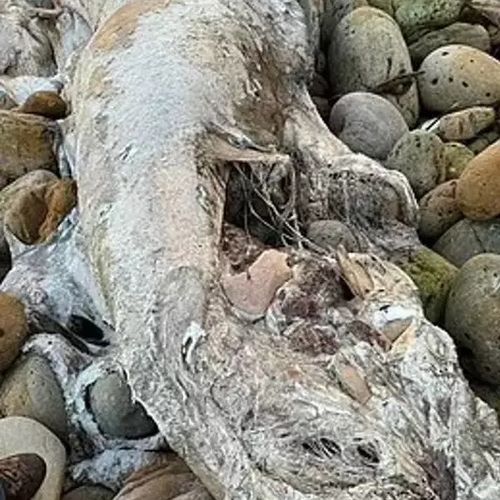
Scientists were amazed by the "faceless monster" on the coast of Yorkshire
Related articles
Log in or register to post comments
